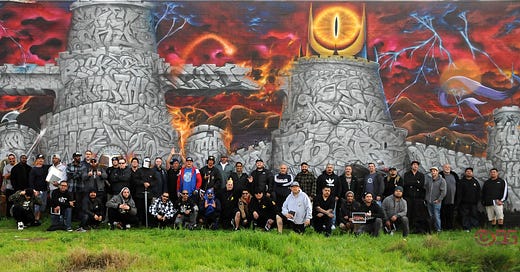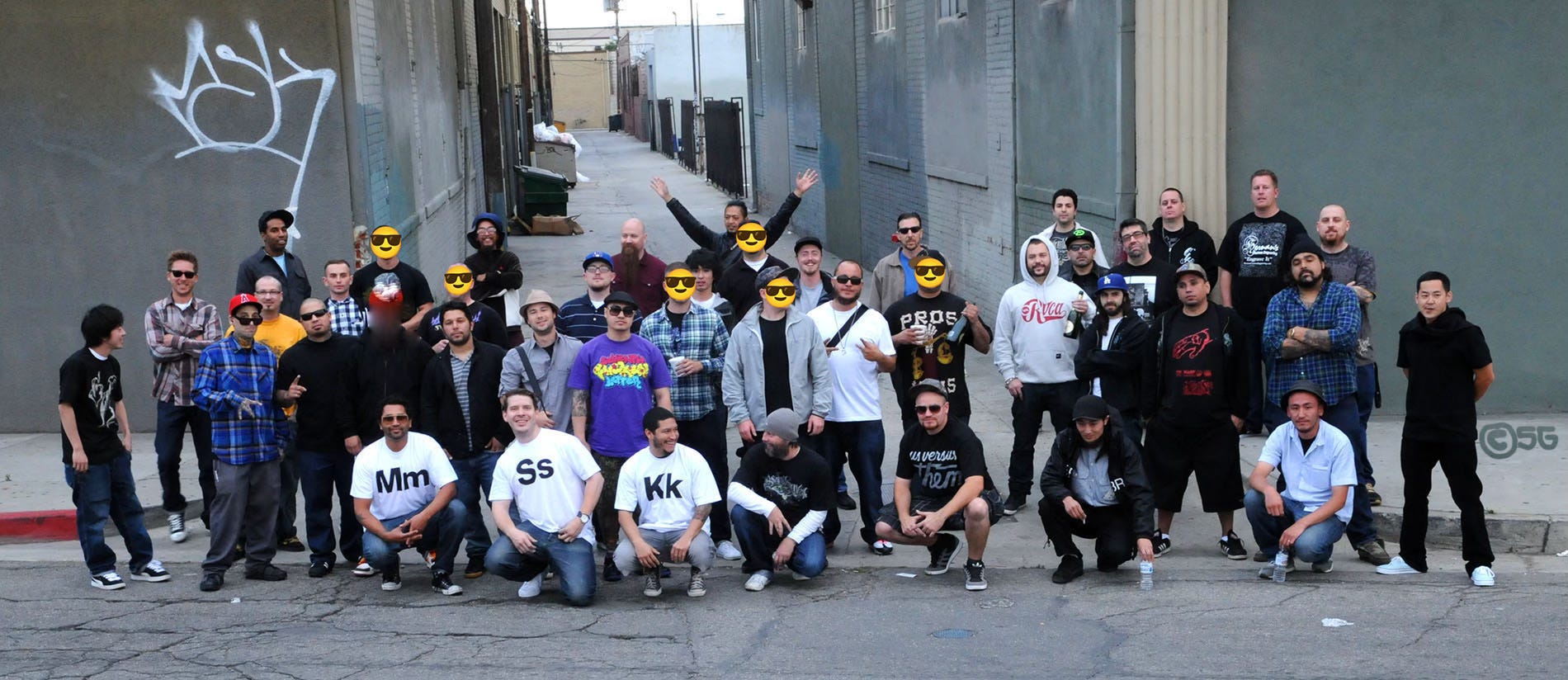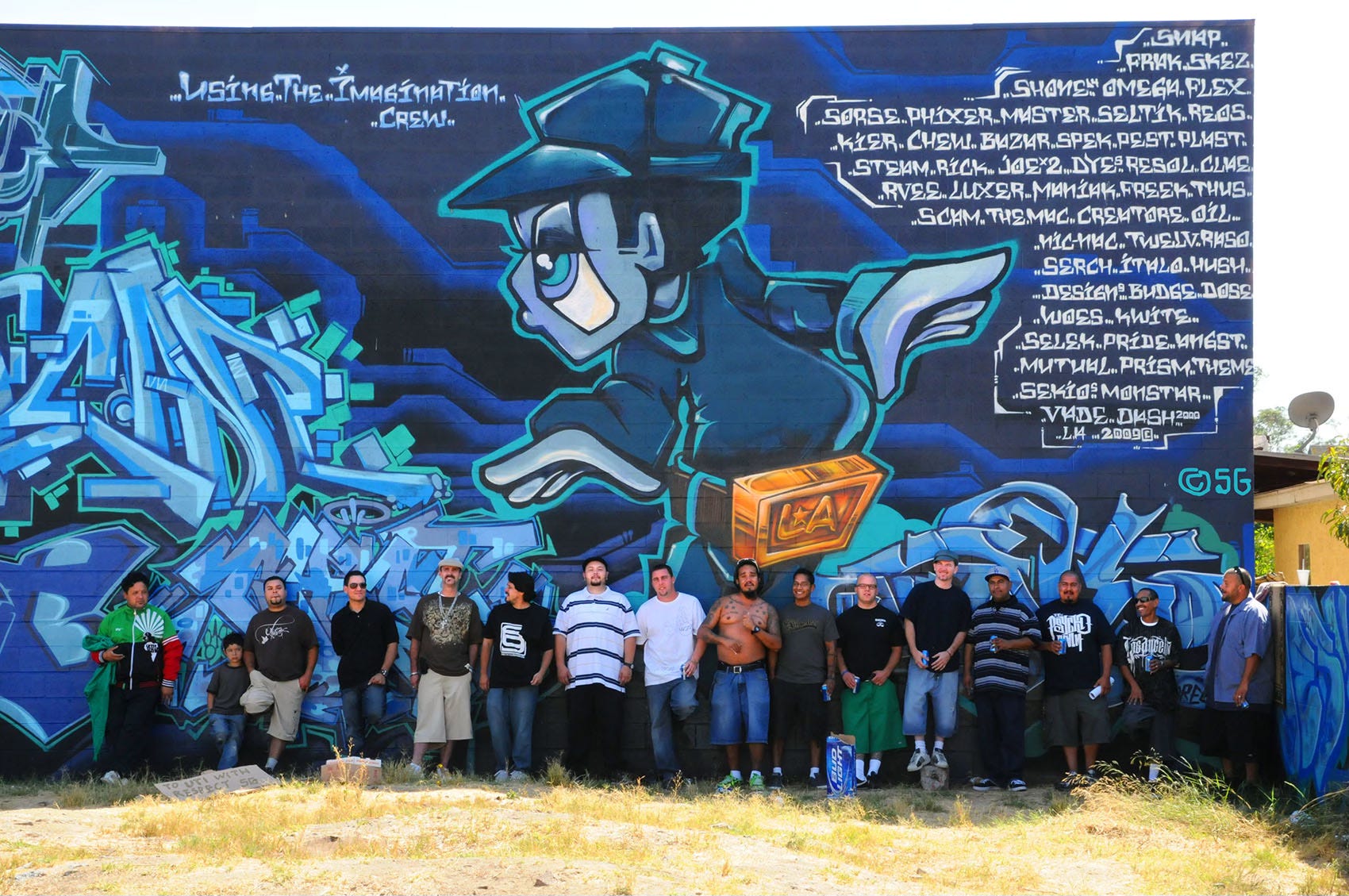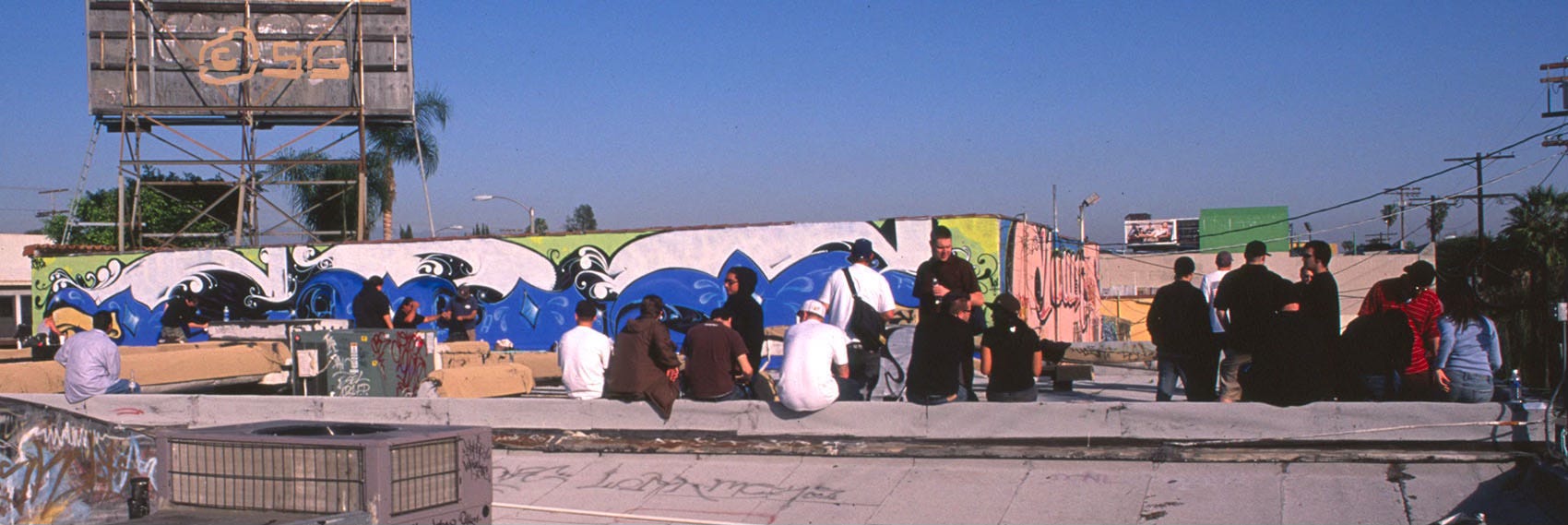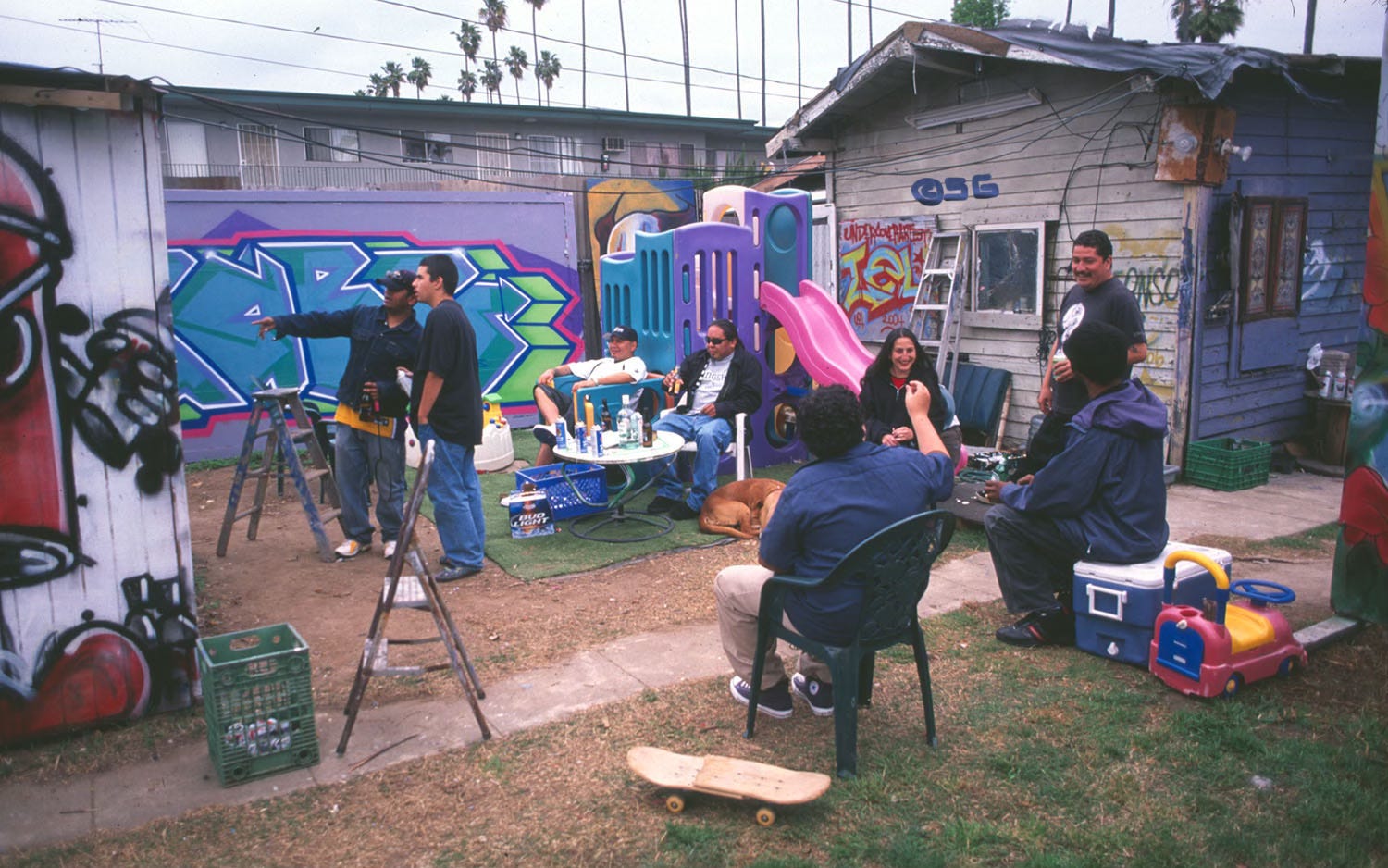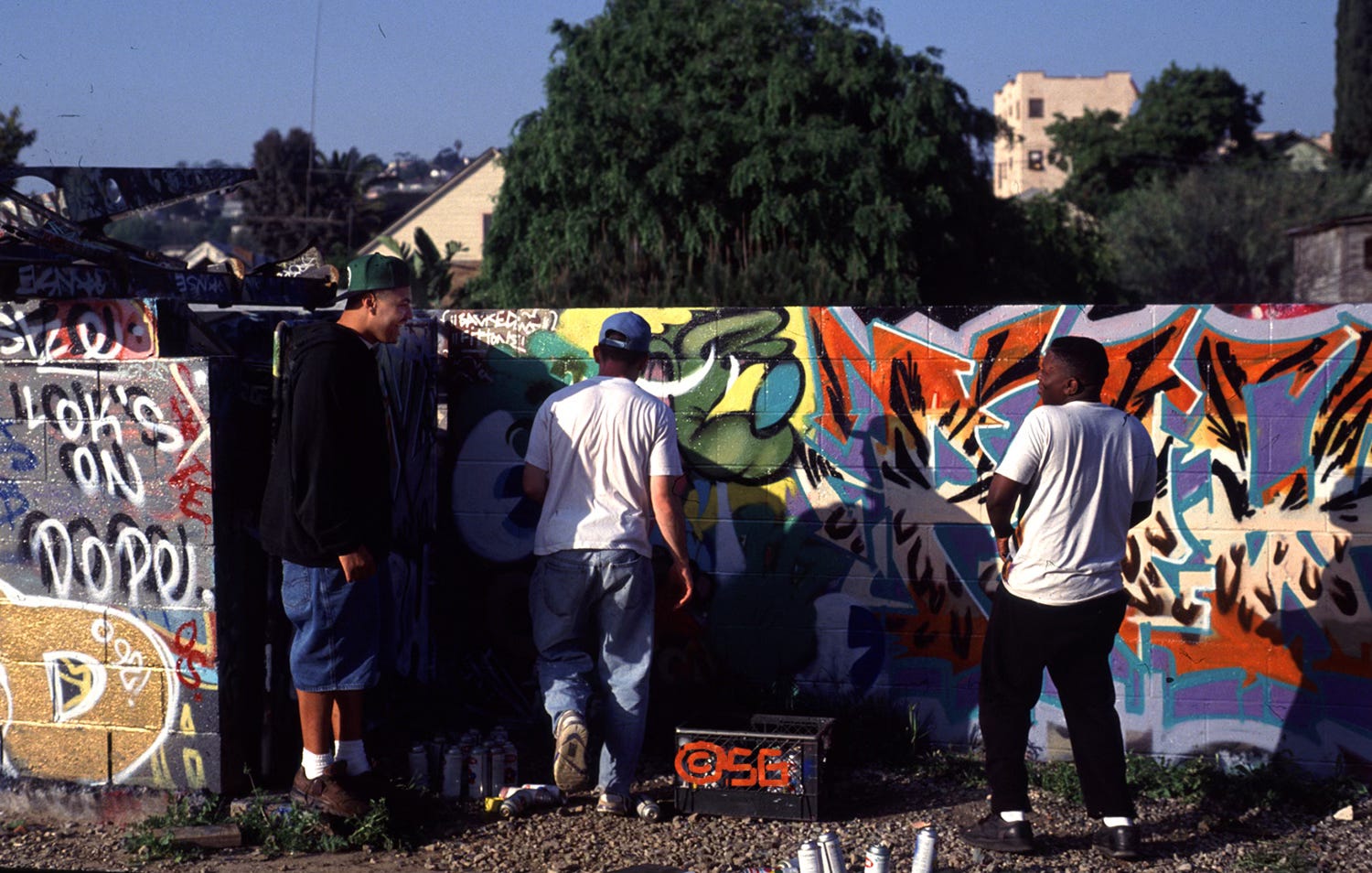Above: UTI Crew (Unite To Ignite. Under The Influence, Using The Imagination), Jan. 2020, not the whole crew. Note the individual names creating the walls of the castle, an apt metaphor for a graffiti crew.
Graffiti became the visual art expression of hip hop although it had its own independent start and evolution into its modern form. It was not until an event sponsored by Henry Chalfant (seminal photographic documentarian and co-author of Subway Art with Martha Cooper and Spray Can Art with Jim Prigoff) that the branches of hip hop, the break dancing, scratching (turntables), DJ-ing and graffiti all happened at the same time. Subcultures usually have five expressive identifiers: art, music, language, fashion and dance.
Above: Left: SKA Crew and friends (“No use crying over spilled beer”): Right; SH Crew and friends at 33 1/3 paint store-gallery event featuring their work.
Graffiti writers, as part of hip hop culture, cover a much more diverse demographic than the stereotype presents, and with all the ethnic and racial tensions that are such an unfortunate common feature of contemporary America, the ecumenical nature of graffiti culture is very encouraging.
Above: Some of the MSK Crew at a 2009 international meeting (thanks to Pysa for helping confirm the face editing)
Within a given crew, members may be high school dropouts or have university degrees (with a few PhDs in the mix, one that I know of with his PhD in criminology, ha!). They come from a broad variety of economic and ethnic backgrounds and family environments. Very melting pot: From Latin America (Mexico, El Salvador, Guatemala, Chile, Cuba, Puerto Rico, Ecuador) Hawaii, Polynesia, Samoa and so on; born in America with parents or grandparents from south of the border, born south of the border and moved here, Black, white, First Peoples, Hungarian, Armenian, Vietnamese, Filipino, Japanese, Chinese, Assyrian/Persian and many mixes, an exact representation of the diversity of Los Angles.
Above: Marvel on the left, using both Hiragana and Kanji (I believe), and he is helping the non-graffiti-litterate read his piece by putting a standard letter inside each letter of his piece. Charm (“The Won Ton Men”) on the right doing nonsense words in Kanji. Both pieces done at Belmont Tunnel, 1991.
Members within a crew may be of a variety of religions, observant or not, agnostic or atheistic. Although it is a dominantly male scene, female writers have been very much in the mix. The great majority of crews are multi-racial.
Above: Some of the participants at the Dream SMD memorial event, Landmark shops 2017
Above: A few of the UTI Crew after finishing the production, mid city, 2009
Even in cases where crews were of one general ethnicity (because they all grew up in the same neighborhood in one case), there was still camaraderie. One writer told me, “In 1985–86 there were three crews: Soul Kings, Latin Lords and Ivory Dukes: white, Latino, Black. They were all friends with each other, so while the crews’ names acknowledged pride in their background, more often than not all three crews were written together, which was a way of showing that these crews weren’t exclusionary and how they were proud to have such talented and creative friends of all nationalities. Later, around 1988, the crew Won-Ton Men popped up, all Asian.”
“As for myself, I’m in a lot of crews (SH, LOD, OTR, UTI) because I’ve always been a person who has mingled with everybody. I took in this graffiti thing and have gotten to know a lot of cool people in different parts of the city. I usually run into someone I know wherever I go. Rich, poor, from any part of the city, any ethnicity and language or religion, everybody is represented in graffiti; it invites all and welcomes any. Writers accept each other for whatever you might bring to the table, and to me that’s the greatest. Everybody can be free to be who they want, and that shows in peoples’ art; some people are colorful, some are bland. It’s a big soup.” – PANIC ONE (2006, interview)
Above: Left; A super hot day in Hollywood in front of Tyke’s piece, Tyke on right, 2009. Right; also 2009, a fun story… Acme, Nerv, Panic and Roten were having a good time painting along the Commerce Tracks when they saw the police helicopter (AKA “Ghetto Bird”) fly over. They looked at each other and said “Well, we know the cops are going to be here soon, do you feel like running?” But it was a hot the-heck-with-it kind of day, so they kept painting and when the black and white came roaring up by the side of the tracks, they kept their cool and told the cops they had the business owner’s permission to pain on that back wall [NOTE: people coming to and from that business never even see the wall in question, so no harm, no foul], and the cops took then at their word (luckily), but as the cops turned around, their car got stuck on the VERY ACTIVE train tracks, so the four guys had to help them get their car off the tracks before a train came through, which they did, and then they continued painting and it was a good day for all!
When I asked why some writers were in several crews, I was told that different mixes of skills and personalities within a crew led to a different experience, vibe and expressions on a wall. Musicians will say the same thing, that group dynamics will vary the results in interesting ways.
While it is not at all unusual for a writer to go on a solo mission, it is common for two or more to go bombing (again, bombing being any illegal graffiti action, but generally at least throwies). The bigger the group, the more coordination it may take and the less spontaneous the plan.
Above: Snap 2015, and Gozer 2012 both at one of the most foul smelling abandoned buildings ever, just north of Chinatown.
At spots where it is more relaxed, there may be more of group in the daytime with friends, girlfriends, boyfriends, a husband, a wife and fans watching the action and hanging out, a great and welcome contrast to seeing a group of youngsters these days sitting around looking at their phones and not even talking to each other.
Above: Belmont Tunnel, 2003. Writers at the wall, locals playing an Aztec version of handball, food cooking on a small grill, a great informal community center.
Above: A CBS Crew gathering for a portrait shot on the roof, Hollywood, 2006
“Everyone starts as a toy…”
A “toy” is someone that doesn’t know the rules of the game, the craft or ethics. The crew provides education through the graffiti family, support and collaboration.
Above: UCA Crew at Tel’s place while a young potential new member is being given pointers by Besk, 2006
If one can get past focusing on the illegality just for a moment, one can see that graffiti culture entails many admirable and “old-fashioned” values. One is unlikely to do it well without mentors, dedication, passion and risk taking, crew loyalty, respect for elders and open dialogue and critique. Crews that don’t have those features don’t last.
Above: Sanborn Yard, 1992. At a theme wall where Delo (on the right, R.I.P.), Perk (left), Relm (center) and Mek did a “Paws, Klaws and Jaws” production just for the heck of changing their letters up. I love this shot because it shows Perk is playing the part of a regular citizen puzzled by the illegibility of graffiti and repeatedly saying “But what’s it SAY?!” I really wanted this shot in my book, but the editor said it looked like Delo was peeing, when he was just laughing his butt off.
The respected veteran writer Cre8 talked about kids wanting his mentorship and telling them they needed learn letter structure, design and color schemes with markers first in an artist black book before going to a wall.
Above: At the much-missed Landmark paint shop in South Central, 2013: an event where youngsters could hang out safely and encourage growing skills. “Lady Bombers Crew” on the right.
Another admirable non-digital aspect of becoming a highly skilled graffiti writer is that those skills require development over time, analogue, eye-hand-brain coordination. One can’t be an actual go-to-the-wall writer by punching in a program or bringing up an app. Recent posts of a graffiti writing digitally programmed machine miss the point by an embarrassing mile; might as well have a machine “listen” to music… where is the embodied experience?
A positive aspect of hip hop culture in general and something that certainly applies to graffiti culture is that the connections are formed by personal interactions of substance. That is, nobody cares what fashion brands of clothes you are wearing, and all that matters are what you bring in creatively and with a proper attitude of working together. The friendships that have evolved over the years have led to international connections in graffiti culture which in some cases has led to international travel to paint and above-ground exhibition as well.
All images copyright Steve Grody
And a few more below for the paid subscribers (less than cost of a beer or fancy coffee for a month of posts!) including AWR at the Pavilion ‘97, K2S at the Little Tokyo wall, LODs, and some of the usual suspects choppin’ it up at the Graff Lab!
Keep reading with a 7-day free trial
Subscribe to Steve Grody's Graffiti Files to keep reading this post and get 7 days of free access to the full post archives.


